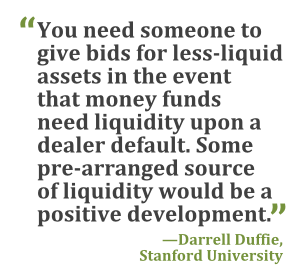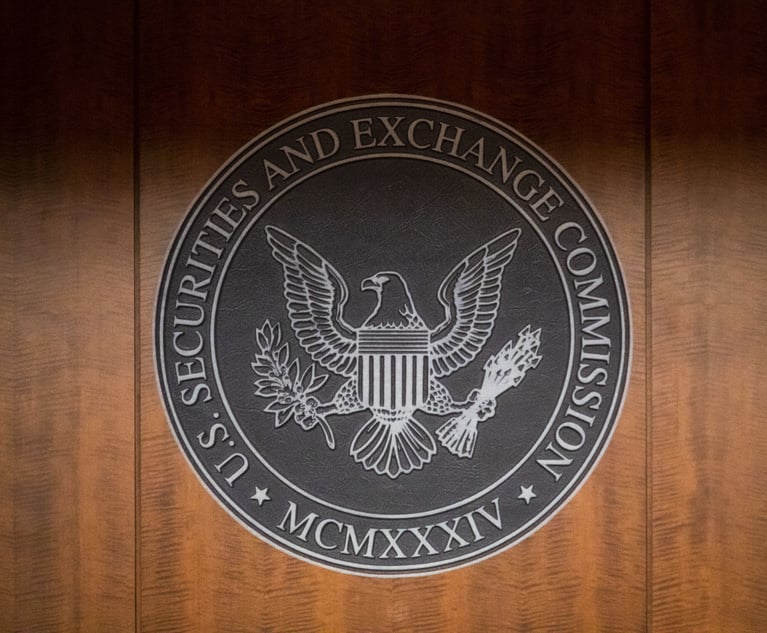Wall Street's biggest firms are close to agreeing on a plan thatwould safeguard the financial markets from the crippling fire salesthat engulfed Lehman Brothers Holdings Inc. and Bear StearnsCos.
|By doing so, the participants seek to reach a solution to whatthe Federal Reserve sees as the last systemic risk in the $1.6trillion-a-day market for short-term funding yet to be addressed:The potential for questions over a bond dealer's liquidity tounleash a wholesale dumping of assets that causes a crisis ofconfidence in the financial system.
|Prodded by the Fed, industry groups with the support of dealers,banks, and investors are coalescing around proposals to guaranteethe most-liquid types of collateral used to borrow money inrepurchase agreements, or repos, said five people with knowledge ofthe talks. Guidelines to ensure investors who accept riskier assetscan price, hold, or sell the collateral if a dealer defaults arealso being discussed, they said.
|“The Fed is right to worry about fire-sale risk,” Viral Acharya,a finance professor who focuses on liquidity risk and regulation atNew York University's Stern School of Business, said in a telephoneinterview on Feb. 25. Lehman and Bear Stearns showed theconsequences when “creditors in the repo market started worryingabout these counterparties.”
Repos are transactions generally used by the Fed's 22 primarydealers—consisting of Wall Street's biggest banks, including MorganStanley and Bank of America Corp.—for their day-to-day financingneeds. In one example of a repo agreement, a dealer borrows moneyfrom a money-market fund in return for collateral, often Treasurybills or notes.
|The dealer agrees to repurchase the securities as soon as thenext day for the principal value plus interest. The collateralitself is held on behalf of investors by JPMorgan Chase & Co.and Bank of New York Mellon Corp., which serve as the designatedclearing banks in what the industry calls tri-party repotransactions.
|The repo market accelerated the fall of both Bear Stearns, whichwas taken over by JPMorgan in 2008 after an emergency bailoutorchestrated by the Fed, and Lehman, whose collapse in Septemberthat year plunged financial markets into their worst crisis sincethe Great Depression.
|Investors who perceived the firms might not pay repo loans or beable to post adequate collateral because of their exposure to theplunging value of subprime mortgages demanded more andhigher-quality assets and refused to finance new repos.
|The funding squeeze triggered sales at Lehman and Bear Stearnsas the New York-based firms unloaded assets at any price to staysolvent.
|Collateral Guarantee
|While Wall Street firms have taken steps to curtail risk-takingin the repo market since the financial crisis, the potential forcontagion remains. The Federal Reserve Bank of New York said in astatement published Feb. 13 that forced selling of repo collateralif a dealer defaults still risks “spreading instability across thefinancial system.”
|“The ensuing price declines could trigger margin calls anddeleveraging beyond the repo market,” the Fed said.
|To address the Fed's concern, repo participants are nowgravitating toward proposals that would have the Fixed IncomeClearing Corp. (FICC), an industry body that processes reposbetween dealers, guarantee the most-liquid assets used ascollateral between dealers and investors in the tri-party system,said the people familiar with the discussions, who asked not to beidentified because the talks were private.
|The guarantee would cover securities such as Treasuries andmortgage securities backed by Fannie Mae and Freddie Mac, whichmake up about 85 percent of daily repo transactions, they said.
|Such an arrangement would eliminate the need for repo investorsto rely solely on the creditworthiness of one dealer by providing abackstop with broad industry support.
|“FICC doing the tri-party clearing would be a possiblesolution,” Scott Skyrm, the former head of repo and money marketsfor New York-based Newedge USA LLC and author of the book “TheMoney Noose: Jon Corzine and the Collapse of MF Global,” said in atelephone interview on Feb. 26. “They have the infrastructure setup to liquidate a failing counterparty.”
|Bari Trontz, a spokeswoman for the New York-based DepositoryTrust & Clearing Corp. (DTCC), which owns the FICC, said it'stoo early to speculate on next steps.
|“DTCC is examining ways in which safeguards can be created tobetter protect the U.S. tri-party repo market from systemic risk,”Trontz said by phone on March 7. “We continue to work closely withour members and other interested constituencies.”
|Liquidation Protocol
|The DTCC won approval from the U.S. Securities and ExchangeCommission (SEC) in January to let registered investment firms,including some mutual funds, become members of its governmentsecurities division, a sign to Skyrm the group may be planning toset up a central clearing body for tri-party repos.
|For riskier repo collateral that wouldn't be guaranteed,including structured notes and mortgage securities withoutgovernment backing, industry organizations are working onguidelines, or best practices, that would include ensuringinvestors are equipped to price, trade, or liquidate the assets inan orderly matter after a dealer default, the people said.
||Investment funds that may have difficulty liquidating suchcollateral during times of distress would be able to enter intopre-arranged agreements with those firms with the ability to do soefficiently, based on the proposals, they said.
|Some academic researchers such as Stanford University's DarrellDuffie have suggested the repo industry needs more drastic changesto effectively prevent fire sales, especially for illiquid andharder-to-sell collateral, from inflicting losses across financialmarkets.
|Not Enough
|Duffie, who co-authored a paper in July 2011 with Fedresearchers titled “Policy Issues in the Design of Tri-Party RepoMarkets,” proposes a highly-regulated utility that could liquidateassets in periods of market stress.
|“You need someone to give bids for these less-liquid assets inthe event that money funds need liquidity upon a dealer default,”Duffie, who presented his vision at a Fed conference on repo firesales in October, said in a telephone interview on March 5. “Somepre-arranged source of liquidity for those assets would of coursebe a positive development.”
|Such far-reaching proposals would require an investment that fewrepo participants would be willing to sign onto and take even moretime to implement, Skyrm said. The centralized guarantor system inthe over-the-counter swaps market, mandated by the Dodd-Frank Act,has already proven to work, he said.
|“We certainly recognize the risks and believe it needs to be amarket-wide solution, and are working to see what the best way todo that is,” Robert Toomey, the New York-based managing director atthe Securities Industry and Financial Markets Association (Sifma),said in a telephone interview on Feb. 27. “We also realize theremay be different solutions for different asset classes within thetri-party market.”
|Sifma, the main trade association for dealers, banks, and moneymanagers in the U.S., has in the past few years been among thegroups to look at the implications of fire sales.
|While repo participants have already succeeded in reducing theuse of intraday credit—one of the other systemic risks the Fedidentified—regulations designed to shore up bank capital and boostliquidity have contributed to a market contraction.
|The tri-party repo transactions have declined 18 percent in thepast year to an average $1.61 trillion in outstanding securitieseach day as of February, from $1.96 trillion in December 2012, datacompiled by the Fed show.
|Conversation Topic
|Any reforms that help mitigate the remaining risks in the repomarket may ultimately increase participation, according to ChesterSpatt, a finance professor at Carnegie Mellon University inPittsburgh, who was formerly the chief economist at the SEC.
|The Fed may use the repo market to eventually drain reserves andguide interest rates higher. The central bank has conducted what'scalled reverse repos with dealers and a list of counterparties,including hedge and money market funds, since 2009 to test itsability to tighten policy. The Fed Bank of New York drained $71.89billion yesterday from the banking system through the reverse-repofacility.
|“Fire sales remain a topic of conversation” for the Fed, RobertGrossman, managing director of macro credit research at FitchRatings, said in a telephone interview on March 6. “This willtherefore be on the market's radar screen.”
|Copyright 2018 Bloomberg. All rightsreserved. This material may not be published, broadcast, rewritten,or redistributed.
Complete your profile to continue reading and get FREE access to Treasury & Risk, part of your ALM digital membership.
Your access to unlimited Treasury & Risk content isn’t changing.
Once you are an ALM digital member, you’ll receive:
- Critical Treasury & Risk information including in-depth analysis of treasury and finance best practices, case studies with corporate innovators, informative newsletters, educational webcasts and videos, and resources from industry leaders.
- Exclusive discounts on ALM and Treasury & Risk events.
- Access to other award-winning ALM websites including PropertyCasualty360.com and Law.com.
*May exclude premium content
Already have an account? Sign In
© 2024 ALM Global, LLC, All Rights Reserved. Request academic re-use from www.copyright.com. All other uses, submit a request to [email protected]. For more information visit Asset & Logo Licensing.







